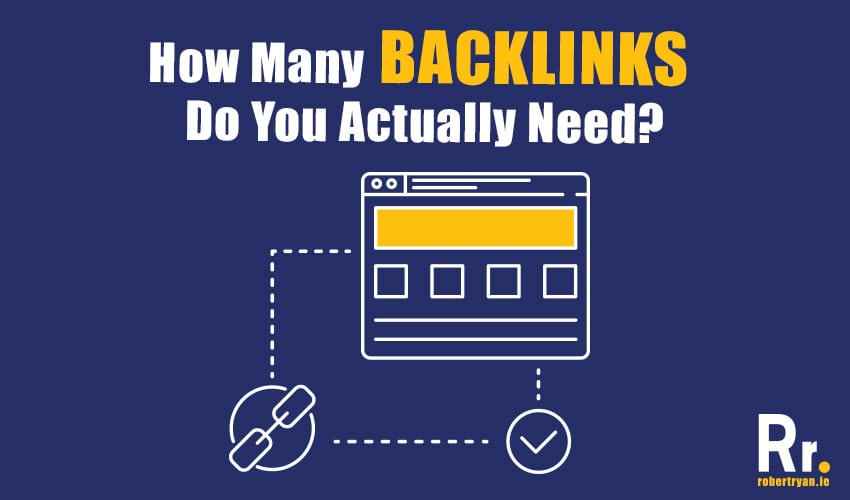How Many Backlinks Do You Actually Need?
Posted on October 5, 2018
Once upon a time, backlinks truly were the lifeblood of SEO. The more you had, the higher you would rank. And building thousands of backlinks a day was not exactly a walk in the park, but it could definitely be done. It could even be outsourced, and all you had to do, in theory, was to watch as you climbed up the SERP ladder.
Then Google unleashed its Penguin, Panda, Hummingbird and Pigeon, and the algorithm was never the same again. After the dust cleared, and said animals settled down into a peaceful virtual existence, there was nothing to do but for SEOs to pick themselves up, and adapt to the newly established reality.
Often was there talk about the ultimate demise of link building. And while their death was proclaimed on numerous occasions, backlinks still remain one of the more important ranking factors. As such, you naturally want to acquire as many of them as you can, and boost your traffic, climb that SERP, and be crowned the master of your universe.
This is when you ask yourself the question: how many backlinks do I need to get to the top?
Well, there is a rather straightforward formula available for calculating the number of backlinks you need to rank number one, but SEOs don’t like to share it, and like to guard it as their very special “secret sauce” recipe. Here’s what you will need though.
Quality in Large Quantities
The first thing they teach you in link building school is that quality always trumps quantity – in every industry, across all languages, in every market, for every search engine. Having one quality link in your hand makes it stronger than the hand of the website sitting opposite you, holding nothing but spam.
Let’s do a simple exercise. Let’s say that it takes you one hour to build a low quality link. Something with a very low domain rating (and authority), with virtually no traffic. And then you build 40 of these links a week, and you end up with 150 of them by the end of the month.

On the other hand, there’s your high quality link. A link from a website that people actually visit, respect and trust. A website that can be considered an authority in its field. A website that will pass on traffic to you. A website that will signal Google that you are a force to be reckoned with. And you can only build one of these for every day of effort you pour into it. At the end of the month, you have around 15 of these.
The 15 will trump the 150, every time. Think of these links as guests at a party. You may have 150 of them, but any meaningful conversation will be lost in all the noise, while people are trying to jostle to the bar, guffawing mini pizzas. On the other hand, 15 well-informed and intriguing guests will be able to hold a mindboggling conversation, while balancing delicate champagne glasses on their knees. And they will cost you less in terms of food and drinks.
While the analogy may not exactly be on point, you do get the point – investing in links that make sense, links that pass value, is always the better route to take, rather than investing resources in links that will have zero return on investment.
Never forget that you will also be acquiring links naturally as you go along. Some will be more or less spammy, others will be of a better quality, but this will all add to the naturalness of your backlink portfolio.
The key takeaway when it comes to links and their quality is to ask yourself a simple question: does this link make sense? As an internet user, do you feel this link would add value to the conversation? Would you like your website to be associated with the website you are chasing?
The same goes for anchor texts and landing pages: does it seem natural, or does it border on keyword stuffing? As the algorithm gets smarter every day, ranking will become much more intuitive. Think user experience more, and how to trick the machine less.
Focus on the Tortoise, rather than the Hare
The other all important issue when it comes to building backlinks is how fast you should be building them. If you try to amass a bunch at breakneck speed, you will likely tumble into a penalty at some point. To use a very tasteless metaphor, you are making turtle soup, rather than roasting a rabbit.
To put it plainly, and to reiterate the point made in the previous chapter – quality takes time. You can build yourself hundreds of spammy links all at once (while most likely paying for them in the process), which will sooner rather than later arouse Google’s suspicions, and you will end up in the doghouse.
You may be sorely tempted to get some links in quickly – especially when a website is new – and while you may be able to get away with dozens of comment links at a time, you don’t want to try to outfox the search engine. Focus your energies on building a reputation, rather than a link, and it will pay off in the long run. After all, you have probably had enough of the “SEO is a marathon, not a sprint” catchphrase, so I am not going to use it here. But remember that SEO is not a sprint, rather it is more of a marathon.

And now for the Backlink Recipe
If you’ve made it this far, I know you are simply dying to get to the part where you can finally calculate how many links you need to be building. So here it is:
- Step 1: See how many links you already have
You can’t start doing the math without knowing your baseline first. Check your Search Console to see how many links you already have, and do a bit of a backlink audit. See how many unique domains are pointing to your site, what kinds of anchors are used, what the overall quality of these websites is, and how relevant they are for your business.
- Step 2: Repeat process with competitor’s links
Some top ranking websites have billions of backlinks from millions of unique domains. Think Amazon and Wikipedia. But that’s not really the type of website you are trying to outrank, is it?
You need to know how well armed the competition is, and the way to do that is to check out their backlink portfolio. I find that using a combination of Ahrefs and Majestic works best for this task. Stick all of their backlinks in a sheet, put on a pot of coffee or boil a kettle, and settle down for some legwork.
Pay attention to the same things you did when analyzing your own links: quality, anchors, distribution, relevance.
- Step 3: Repeat process with desired keywords
Now that you have amassed all this data – about yourself and your competition – the time has come to whip up a dish.
The number of keywords you will need is in direct correlation with the number of links the top ranking page for a desired keyword has.
Note: the quality of the page itself also plays a huge role in the equation, but let us assume that your page is of the same or better quality than the top ranking one.
How To Rank for Keyword X
So – to give you an example. You are trying to rank for keyword X. The pages that rank in the top ten have thousands of backlinks. You have none. Your page is new. You might not make it.
However – if the top ranking pages have only a few dozen backlinks, you have a decent chance of outranking them.
Don’t forget that there is much more to it than this simple equation, no matter what I said in the introduction. Links may be an important ranking factor, but they are never the only one.
Nevertheless, doing this kind of analysis will help you find low competition keywords with a decent search volume that you can actually rank for. And once you rank one page, ranking the next one will be just that much easier. Also never forget that building links is a never-ending process. Even when you make it to page one, or rank one, you need to keep working on them.

The Bottom Line for Backlinks
In conclusion, the number of backlinks you need to rank number one for a certain keyword will depend on the competition in your industry. If it’s a crowded environment, you will need more links, just because your competitors already have them. If there’s more room to jiggle, the number of links will be significantly lower.
Bear in mind that you don’t want to focus on competitor backlinks alone. While they may be a great starting point, you need to build links that are unique to you. There are countless resources online about the different ways to build backlinks in 2018 – try some of these strategies out. A variety of links will not only boost your backlink portfolio, it will also drive different types of traffic.
When embarking on a link building campaign, apart from using all the usual techniques, we like to ask ourselves a few simple questions: who needs the product this website is selling; how do we know they need it; where do they spend time online; how do they look for products; how can we reach them, where would they most likely notice us. The rest is a sea of emails, a mountain of articles to write, countless questions to answer, and a lot of fun to be had.
Because, never forget, building links is not only about getting to the top. It is about making connections with the people who can become leads and valued customers. It is about making a name for yourself. And you don’t want to be doing that in the shadiest neighborhood online. If you want to get some help with your SEO efforts then get in touch.
This is a quest post and thanks to Andrea Gombos from Cube Digital for submitting it. If you’d like to submit a quest post then get in touch.


Got something to say?